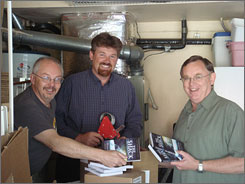There is a sense of romance about books becoming phenomenally successful. There is an even greater sense of romance when the book is self-published, because we usually get a great dollop of homestead heart-warming stories of children, Christmas, good-will, good-luck, together with simplicity, reverence, perseverance and courage; all painted on a landscape of financial and artistic hardship. The aftermath and real story, under analysis over time, often reads more like the accidental recipe of an author looking to see their book in print rather than any deliberate or prescribed publishing endeavour.
I am not going to start our adventurous story with the author at the centre of this piece, but instead, with Wayne Jacobsen, a former pastor and author of So You Don’t Want to Go to Church Any More. Jacobsen decided to self-publish and print his own books of spiritual parables and essays and used his social connections to help market and sell the books. He gained notable local success and managed to organise some book signings. One of these book signings was at a store in Gresham, Oregon in 2005. Towards the end of the signing, Jacobsen was approached by a local writer who had already read his book of parables and was eager for him to take a look at the manuscript of a book he had taken along with him.
The local writer was William Paul Young, a sales representative and website designer. Young was a writer at heart and he often wrote poems and stories to give away as gifts to family and friends. He had written his manuscript throughout 2005, desperate to have it finished before Christmas so he could get a few copies printed and bound in Kinkos and present them as gifts to his six children. There is a single defining book in every writer’s career. For some, it may be their first book, for others, it comes after many attempts, with each book, the voice and story becomes more resonant, lucid, honest and powerful. In many cases, each writer tells the same story a thousand different ways, through a thousand characters and a thousand plots. Yet, at the heart of every story—enriched with colour, emotion, adventure and insight—lies the writer’s own personal story.
William Young wrote his book as a way of expressing his journey through an early life of sexual abuse, an adulterous affair during his marriage and the battle to reconcile his own sense of pain and shame with his religious faith, and his ultimate journey of love, light and redemption. He wanted his story to help his children ‘better understand their own dad and the God he was so in love with.’ His book was a testament to his own journey and a lasting gift to his children. Young would later describe the potent physical symbol of his book as ‘the ugly place inside where everything awful was hidden away’.
Wayne Jacobsen took the manuscript of the book from Young and read it. He was ‘taken immediately’ and over the following sixteen months with the help and support of Jacobsen’s friend, Brad Cummings, also a former pastor from Los Angeles, they worked with Young on rewriting and editing the manuscript. Jacobsen and Cummings worked with Young until they felt they had a manuscript they could take to publishing editors. Nearly forty percent of the original manuscript had been cut and rewritten, particularly the sections they felt were too immersed in Christian theology and may not appeal to a wider audience. They began pitching the manuscript to twenty-six different publishers. The Christian publishers felt it too harsh and ‘edgy’, and the mainstream publishers thought it too ‘Jesusy’ and preachy.
 Jacobsen and Cummings finally gave up trying to place the manuscript with a publisher. They felt with the interest and support amongst friends, family and the wider Christian community that they had a book worth publishing themselves. Jacobsen and Cummings formed a business partnership and created an imprint called Windblown Media with the specific purpose of publishing Young’s book.
Jacobsen and Cummings finally gave up trying to place the manuscript with a publisher. They felt with the interest and support amongst friends, family and the wider Christian community that they had a book worth publishing themselves. Jacobsen and Cummings formed a business partnership and created an imprint called Windblown Media with the specific purpose of publishing Young’s book.The Shack by William P. Young was published by Windblown Media in 2007. We could engage in romanticisms here and say The Shack was greeted with rapturous and critical acclaim, but actually, like many self-published books, beyond Christian communities, websites, blogs and Radio stations, the interest in The Shack was concentrated and steady, and initially in its first year of publication, remained the preserve of Christian and spiritual circles. Many self-published authors would have been ecstatic to have achieved this considering Young’s early goal was simply to present bound Kinkos copies to his children. By early 2008, the continued word-of-mouth, blog to blog, church gathering to church gathering began to build an extraordinary momentum, and by June The Shack sensationally debuted at the number one position on the New York Times paperback fiction best sellers list. Within weeks, it seemed the nation was only talking about one book.
Jacobsen and Cummings have said they only staked $300 on the marketing campaign for the book, and this was mainly on setting up a website, but since the book’s rise to the bestsellers lists, it transpires Cummings actually pushed several credit cards to their limit to finance the print and marketing push on The Shack.
As of February 2010, The Shack has over seven million copies in print worldwide, spent seventy weeks holding the number one spot on the New York Times bestseller list, and it continues to remain in the top ten to date. Windblown Media entered a co-publishing agreement with Hachette Book Group USA in 2008 (using FaithWords imprint), by then the book had already sold more than one million copies, and a division of Hachette overseas, HodderFaith, now publishes the book in the UK, where it has just achieved a half-million in sales.
The success of The Shack demonstrates what word-of-mouth and community networking can do for a self-published book, but more interestingly, the market strength of religious books in the United States, within and without the book publishing industry. It strikes me as no casual coincidence that a large trade publisher like Thomas Nelson (ranked 6th in US) started a self-publishing imprint service last year and Xulon Press, is also a notable Christian author solutions service operating in the USA with a strong reputation. It seems the Christian market in books and social networking (old ways as well as new) may present the ideal template for self-published authors to maximise the success of their books.
Postscript to The Shack
Sarah Weinman wrote in July 2010 in the Los Angeles Times about how one of the most successful self-published books was the subject of law suits and counter suits between the author and his two original supporters, pastors Wayne Jacobsen and Brad Cummings.
“For nearly eight months, the trio have been mired in a series of lawsuits, accusations flying over improper accounting practices, millions of dollars in missing royalties, contract breaches and copyright disputes. Hachette, meanwhile, just wants to know to whom it owes money — and how much.”
You can read the rest of that LA Times article here.
The Shack was written by William Paul Young. He was raised amongst a stone-age tribe in New Guinea by his missionary parents. The Shack was originally a story written for Young’s six children, to explain his own harrowing journey through pain and misery to ‘light, love and transformation’. The story, in which the father of a murdered child encounters God in the form of a larger than life Afro-Caribbean woman, was later re-worked in collaboration with two friends, and found success initially through word of mouth and the $300 the men spent on creating a website. The controversial yet thought provoking tale has received rare and unprecedented success.
[This article was originally published in October 2010.]
Related articles
- Canada’s largest book distributor declares bankruptcy (arts.nationalpost.com)
- A Christian Mega Bestseller Teaches You That God Likes to Party [Christian Book Club] (gawker.com)



